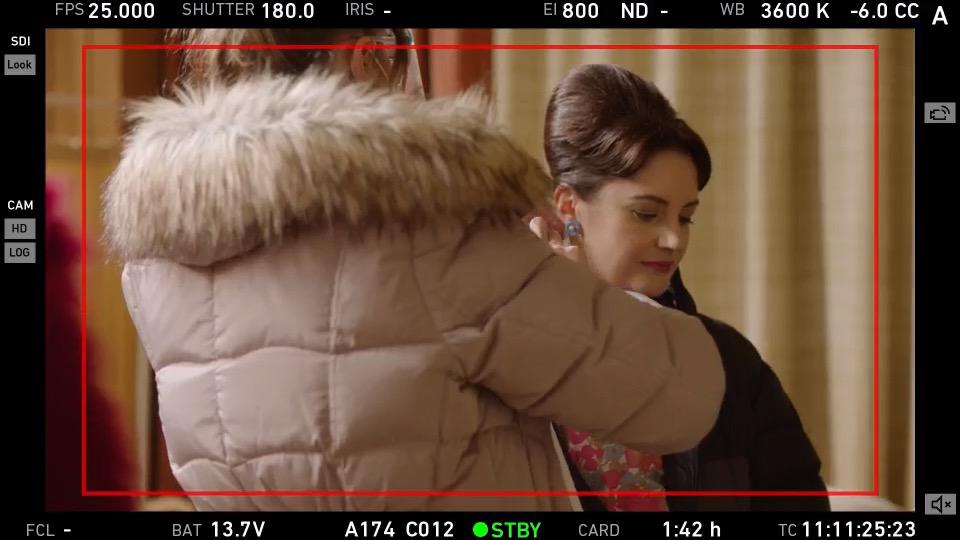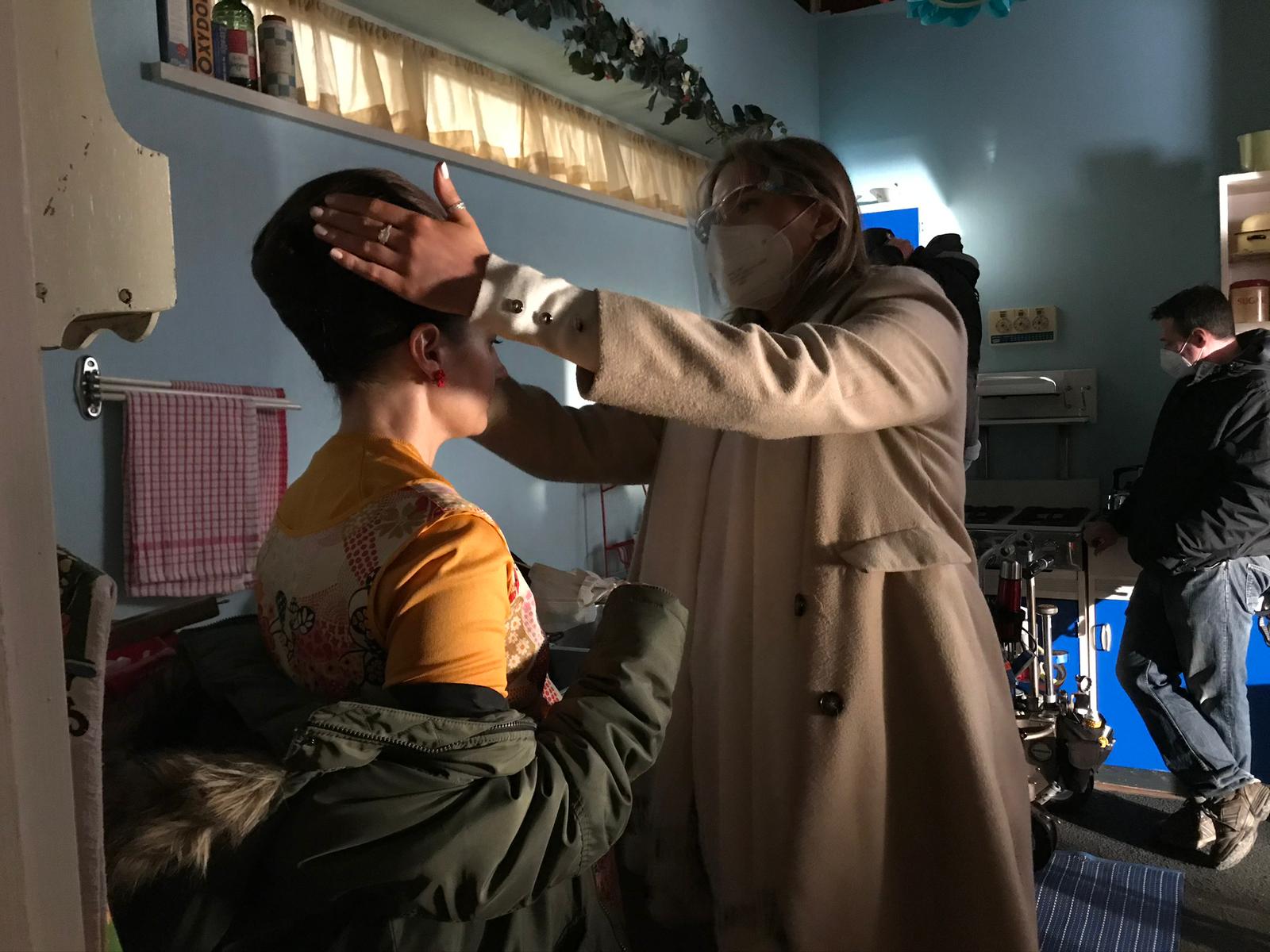On set with a TV & Film MUA

When BBC’s Call the Midwife filme the third episode of its 12th series, PB was given AAA to go BTS (that’s access all areas and behind the scenes for those of you who don’t know the lingo) with make-up artist Olivia McMullen.
McMullen has worked on the show since its 10th season, joining originally as a junior for a season before being promoted to a make-up artist. Lollie Hancock shadowed her for a day back in July 2022 and got to understand what a day in the life is like for an MUA on what is arguably Britain’s most popular period drama.
What does a TV make-up artist do on set?
Dependent on which scenes are being shot with which artists, no two days on set are the same.
The day we visited, Cusack had multiple scenes – meaning multiple make-up looks.
With a 6:50am call time, the first stop was the make-up trailer where Cusack was already in her chair.
McMullen started with heated rollers – to give the hair maximum time to set – before turning her attention to make-up.
“With Nancy, where she’s younger, we can have more fun with her make-up in the day-to-day than with the older characters,” she says.
While Cusack’s character has a slightly more “modern” (for the time) look compared to her character’s peers, tattoos were still years away, meaning McMullen must work to cover any visible ink.
“When you’re covering tattoos, you have to start with colour correction,” she explains, beginning with a red/orange airbrush before layering a neutral shade to match Cusack’s skin tone on top.
The ’60s saw make-up used as a form of expression for young women, reflected in Nancy’s make-up, with McMullen drawing inspiration from a ’60s icon.
“Twiggy was the, the heart of the sixties,” she shares, explaining where Nancy’s exaggerated lower lashes and dark crease came from. “In day-to-day, or ‘civvy’ (short for civilian) looks, we can experiment more.”
After prepping for the day, the MUAs, costume department, and other crew members will watch scenes as they’re filmed on monitors, constantly keeping an eye out for anything that could cause continuity errors, such as a piece of hair in the wrong place.
In the breaks, as the crew resets the scenes, the team run on set to touch-up any imperfections with a condensed kit they bring.
Ultimately, Call the Midwife centres around nuns and nurses, so, when the habit goes on, the eyeliner comes off. The time restraints while filming mean that quick changes for both costume and hair and make-up sometime take place on set.
The transformation from Nancy’s day-to-day look into a nurse is easier than the other way round, as the make-up design when “working” is stripped down and natural.
“A lot of the midwives, nurses, and nuns have been part of the cast for six or seven years, so their make-up doesn't really change, and when they’re working, the nuns don't really wear much make-up.”
The make-up style required on set may have similarities to at-home application, but there are other factors that need to be considered.
“With the 4D cameras that are used on set, you have to think about making sure you’re not packing the make-up to heavily, and how lighting will affect powdering.”
McMullen uses modern products to create looks reflective of the period. “I just incorporate these products to suit the characters, and use my usual tools and equipment in a different way to get the results.”

How do make-up artists prepare for TV filming?
“Caroline (Rose, the hair and make-up designer) told me I would be making up Judy (Parfitt, who plays Sister Monica Joan), Megan (Cusack, who plays Nancy), and the guest artists, who are different every episode.”
The job goes beyond working on shoots, beginning with a week’s prep to prepare for filming.
“We bring all our kit in and get ready for the shooting week,” explains McMullen, adding, “We get the artists (cast) to come in to practise, just to make sure the looks fit the character and they’re happy with their looks as well. Anyone who needs a haircut ahead of the shoot will get one in that week.”
Consistency is key when it comes to filming a TV show as, to avoid continuity errors, the make-up artists have to ensure each hair is in perfect place and make-up is the same from scene to scene.
To keep on top of this, characters usually have one or two set “looks”, dependent on whether its daytime, night-time, or a work scene. Due to the show being a period drama, a lot of mood board and inspiration pics are hung around the make-up trailer for the MUAs to reference as they build the looks.
“Some of the characters have been part of the show for six-plus years, so their make-up doesn’t really change,” explains McMullen. “Obviously, the nuns in the show don’t really have extravagant make-up either.”
“For new or younger characters, we tend to do our own research into what was popular in the 1960s, and we even incorporate some more modern aspects with a ’60s influence.”
Throughout a day’s shoot, the MUAs constantly take reference images on iPads, making notes on what products were used and which shades they selected so that, if they need to reshoot a scene, the look can be recreated.
Top-ups need to be done throughout the shoots as well, so the make-up artists watch the scenes as they’re filmed through monitors, meaning they can easily run onto set to reset hair, reapply lipstick, and add anything else the character may need.

How to get into TV make-up work
McMullen did a two-year course at Brushstroke Make-up Academy, a college specialising in make-up training for the entertainment industry, where she studied Make-up and Hair for film, TV and theatre.
“We did theatre hair and make-up, period hair and make-up from the 1920s to the 2000s, wigs and facial hair.” shares McMullen.
“We also did TV, which was basic make-up for news presenters, and prosthetics and special effects.”
The academy encourages and facilitates work experience opportunities, often being asked by external companies and brands to put forward students.
“I did photoshoots for John Lewis and Waitrose, a photoshoot for Carrie Hope Fletcher’s album, and worked backstage at Toni & Guy show.”
McMullen then went on to land her first regular TV role, on BBC Three’s ‘Mum’.
“Since leaving school, I wanted to be an MUA, mainly in TV and film – I’ve always been quite creative and enjoyed make-up.”
Working in the TV and Film industry, unsurprisingly, is a lot easier if you know the right people. The best way to get onto a new job is through friends from old ones.
“I worked on EastEnders with another make-up artist who had previously done CTM, and mentioned to her that I was looking for a new role when EastEnders wrapped. She said she may have a job I’d be interested in, and a week later I got a phone call interview.”
“As it was during Covid-19, I just had a Facetime interview with the hair and make-up designer, then met her for a coffee when we could, and spoke a bit more about the job.”
When a team was being put together for the new season, McMullen contacted the former designer to express her interest in staying on, who then put her in contact with the designer for series 12.
“This time, with Caroline, it was just a phone call as I’d already worked on the show.”
Reflecting on her time in the industry, McMullen shares, “In the four years I’ve been working in TV, it has allowed me to broaden my skills and experience and work with some highly talented and lovely people.
“I love my job as a hair and make-up artist and to be able to see the work projected on to a TV screen makes me really proud.”


